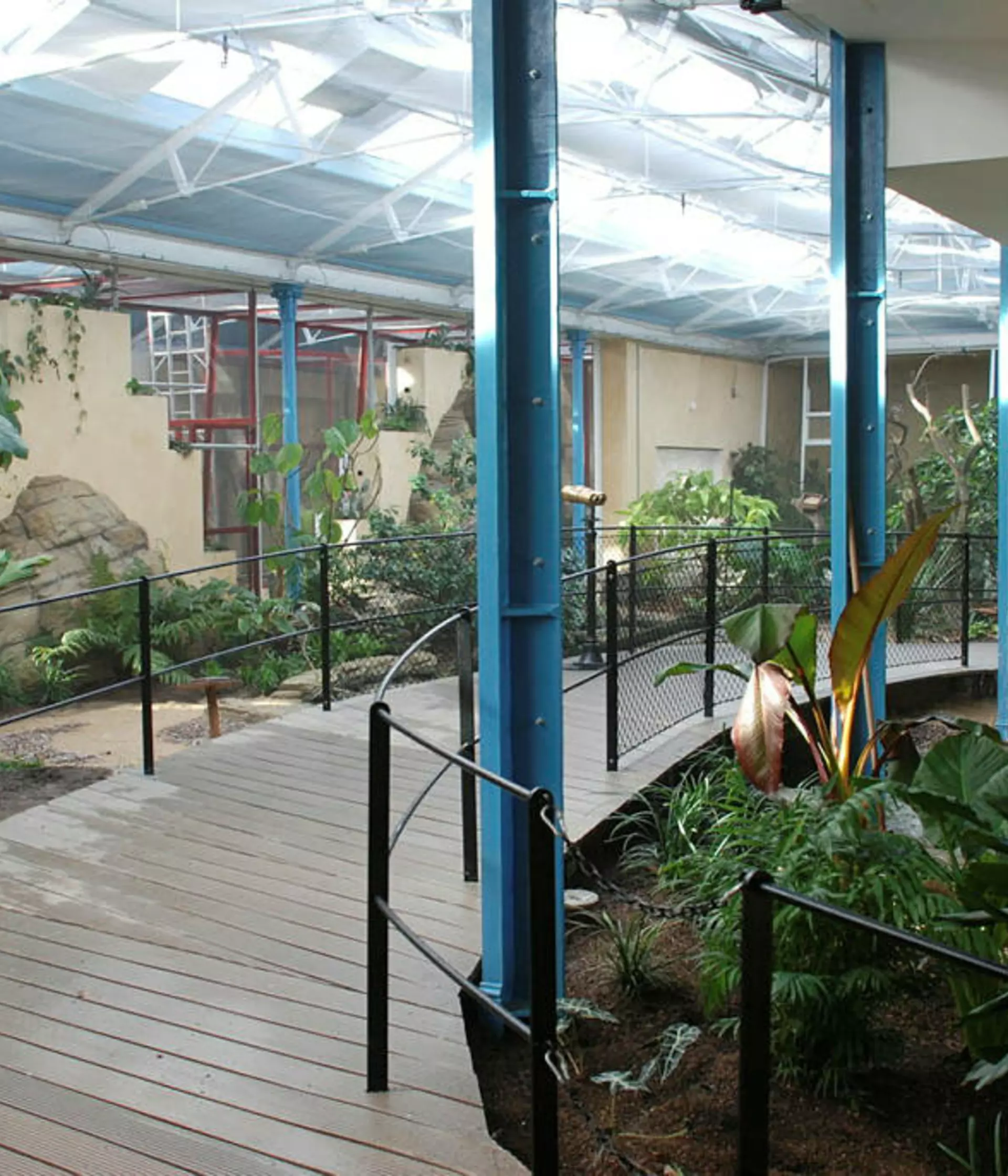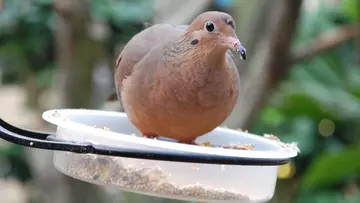
Bird walk-through
Take flight to the Blackburn Pavilion, and be transported to our wonderful tropical walk-through! Come nose-to-beak with exotic laughing thrushes, soaring starlings, nosey victoria-crowned pigeons, and plush partridges.
Our bird allows visitors to enter a world of lush rainforest foliage and waterfalls, and catch flashes of colour from the vast array of beaks, wings, and feathers fluttering on display, with many free flying around their new tropical home.
An important part of London Zoo’s heritage, Blackburn Pavilion provides a tranquil tropical home for more than 50 different species of birds. Originally built in 1883 as a Reptile House, this marvellous Victorian building has been restored to provide our flocks with a splendid place to spread their wings.
Follow the boardwalk into the tropical walkthrough where the rainforest environment is recreated. Continue through to the cloud forest where you will be captivated by the iridescent hues, tiny sizes and super-fast wing beats of these tiny birds as they flutter past in free flight. The lofty pavilion provides an abundance of space for the birds to fly through the foliage; you will feel like you are meandering through the heart of the Amazon!
Birds play a vital role that is integral to the environment around us. As well as giving visitors the opportunity to experience and share the birds’ habitat, Blackburn Pavilion provides safe surroundings for species that are in danger of becoming extinct or are already extinct in the wild, including the Socorro Dove, which is bred only in captivity until they can be reintroduced to the wild to ensure the survival of the species.
So put away your binoculars and come see these amazing creatures of flight up close and personal in the Blackburn Pavilion.
Step back into the buildings history
Blackburn Pavilion history
Blackburn Pavilion originally housed crocodiles, and is one of the only Victorian animal houses at the Zoo to remain in use today.
Birds at Blackburn Pavilion
Socorro dove
You might not have spotted this understated dove among the colourful inhabitants of the Blackburn Pavilion. With pink terracotta feathers, the Socorro dove blends in where many species of the bird world like to shout loud – only an iridescent patch of pink on the back of its neck sets it apart. In fact, the Socorro dove is the rarest bird at London Zoo, and hasn’t been seen on its native home, Socorro Island, since the 1970s. Animals that evolve on islands without predatory mammals tend to show no fear towards humans or other introduced animals, and it’s thought that the introduction of feral cats to Socorro wiped them out. The Socorro dove is officially categorised as being as Extinct in the Wild on the ICUN Red List of Threatened Species.
Thankfully, London Zoo is part of a worldwide breeding programme with 35 other zoos, working to keep the species from being lost forever! We bred our first Socorro dove in 2006 and last year celebrated the hatching of four Socorro dove chicks. They can be seen wandering around their tranquil forest home. Plans for reintroductions are underway in Mexico and, one day we hope to see the descendants of London Zoo’s doves back on the island of Socorro.

Blue-crowned laughing thrush
One of the first things you’ll hear as you enter the Blackburn Pavilion is the chatter of our blue-crowned laughingthrushes. As their name suggests, this species is known for its laugh-like call. In fact, laughingthrushes are part of a larger group of birds called ‘babblers’, which tells you something about how much they like to talk! Blue-crowned laughing thrush are social birds, and live and forage in noisy family groups. They’ll even roost together in small colonies, building nests in the same tree, and young birds have been recorded helping their parents raise their younger siblings.
Sadly, the species’ bright colours and big personalities have also caught the attention of the pet trade and fewer than 300 will adult birds are thought to be left in their home of Wuyuan County, China. Other populations may have existed once, but they seem to have been lost. Asia’s songbirds are under real pressure from a cultural tradition of keeping pet songbirds which threatens the stability of bird populations and the wider ecosystem. London and Whipsnade Zoos are working with other European zoos to direct funding and research to protect birds like the blue-crowned laughingthrush, as well as breeding healthy populations in our Zoos so we can learn more about the species and contribute to reintroduction programmes.
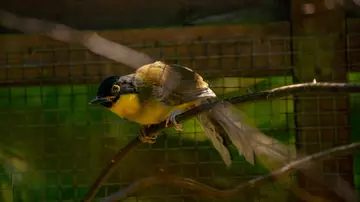
Victoria crowned pigeon
The second of our ‘crowned’ species, the Victoria crowned pigeon from the island of New Guinea certainly earns its royal name – it’s even named in honour of Queen Victoria! The Victoria crowned pigeon possesses an incredible piece of headgear, which males use to impress females during breeding season. The species is also a giant of the pigeon world: it is considered the world’s largest pigeon and is 10 times the size and weight of London’s pigeons. Victoria crowned pigeons are relatives of the dodo, which was once the world’s largest pigeon until it was hunted to extinction in the 1600s.
Victoria crowned pigeons spend most of their time on the forest floor, looking for fallen fruit and seeds, and will only fly into the trees if alarmed or to roost at night. They’re very curious and confident birds, so don’t be surprised if you spot our three strutting towards you along the Pavilion walkway. Just keep calm and still, and they’ll walk right by. Did we mention that birds are actually a type of specialised dinosaur that survived the extinction of other dinosaurs 65 million years ago? Standing next to such a large bird it’s not so hard to imagine anymore!

Collared trogon
This red-breasted beauty is found across Mexico, Central America, and in South American countries like Colombia and Bolivia. Members of the trogon family (Trogonidae) are also found in Africa and Asia. Their unusual name might sound like a Doctor Who villain, but in fact it means ‘nibble’ or ‘gnaw’ in Ancient Greek and refers to how they gnaw holes in trees to make their nests.
They perhaps don’t look it, but collared trogons are actually masters of disguise. They spend much of their time motionless, and will turn their green backs towards potential predators and tuck away their red bellies as much as possible – camouflaging themselves against the green foliage. They can even turn their heads 180 degrees, like owls, which helps them to keep an eye on would-be predators. And if that doesn’t work? They can drop their tail feathers, acting as a defence mechanism and a distraction to predators!
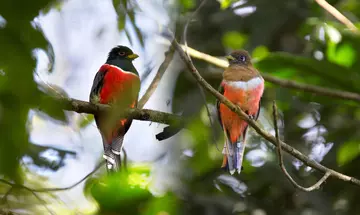
Bali starling
The Bali starling’s bright white plumage and blue eyes make it a standout species in our aviary, but you’ll likely hear it before you see it. The Bali starling is a raucous bird, whooping and chirping for all to hear. You may even turn to see whose phone is going off – they sound remarkably like a phone ring. Sadly, this is another of our rarest species. Like the blue-crowned laughingthrush, the Bali starling’s beautiful plumage and attractive call has made it a target of pet traders, and there are thought to be only 100 left in the wild – though increased protection and reintroductions has seen their population rise from as few as six wild birds in 2001.
Another member of the starling family to look out for in the aviary is the amethyst starling – recognisable for the incredible iridescent plum-coloured feathers on their head, wings and tail. Unlike the Bali starling, which is limited to the Indonesian island of Bali in southeast Asia, the amethyst starling is found across sub-Saharan Africa. From Senegal in the west, to Kenya in the east, and as far as Botswana in the south!
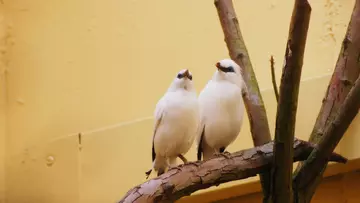
Javan green magpie
The Javan green magpie can be found just outside in the outdoor aviaries and we couldn’t resist telling you about them. With its black bandit mask, bright red beak and fluorescent green body, the Javan green magpie looks like it could have its own crime-fighting comic book series. Magpies belong to the same family as ravens and crows, some of the world’s cleverest birds, so we suspect they wouldn’t make bad detectives either. They even have an exciting origin story – Javan green magpies are actually born blue, and get their green colour from a pigment, lutein, in the insects they eat!
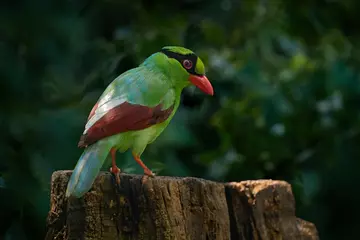
Like our Bali starling and Victoria crowned pigeon, the Javan green magpie is found in Indonesia – the world’s most biodiverse country – on the island of Java. Sadly, like the Bali starling, the magpie is another victim of its good looks, and has been collected to the point of extinction by pet traders. Just 50 are thought to live in the wild. Thankfully, London Zoo and a number of European zoos are working together with the Javan Government to build a breeding population of Javan green magpies, with the hope of reintroducing them to the wild and restoring their numbers.
